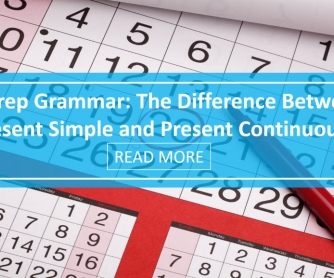
English has two main present tenses: the present simple and the present continuous. The present simple expresses something that happens all the time or is always true. For example, I speak Japanese. The present continous expresses something that is happening right now. For example, I am speaking Japanese.
Lots of languages only have one present tense. As a result, having two present tenses can be confusing and lead to a lot of mistakes. For example, students may say I am coming from Germany or I do my homework now. Read on for some ideas and activities to help you make sense of the two tenses.
Arrange the Sentences
Scramble or jumble up present simple and present continous sentences on the board and ask your students to unscramble them in pairs. As students give you the correct answers, ask them to explain the difference between the two sentences. The present simple is something that is always true or happens every day and the present continuous is happening now.
Sample sentences:
| Present Simple | Present Continuous |
| I live in [your city]. | I'm living with my mother. |
| He speaks [Chinese]. | He's speaking [Chinese]. |
| We sit at the front of the class. | We're sitting outside in the sun. |
| I don't work very hard. | I'm not working today. |
Negative to Positive
Write up five sentences and ask students to work in pairs to make them negative. This is difficult because students will need to know the forms of both tenses quite well before you do this. Make up your own sentences that your students might find interesting.
Sample sentences:
| Positive | Negative |
| She's living in Ibiza. | She isn't living in Ibiza. |
| Earth goes round the moon. | Earth doesn't go round the moon. |
| She works five days a week. | She doesn't work five days a week. |
| We're working tomorrow. | We aren't working tomorrow. |
State Verbs
State verbs are not usually used in the present continuous. Draw a table on the board like the one below and ask students to put the words from along the bottom in the correct places. You can also ask students to write five sentences using some of the state verbs. They can share the sentences with a partner and then the rest of the class.
| senses: | smell | taste | sound | |
| feelings: | hate | want | ||
| always true: | cost | belong | ||
| knowledge: | believe | prefer |
Place these words into the box: know/hear/like/love/have/weigh/understand
Answers:
| senses: | smell | hear | taste | sound |
| feelings: | like | hate | love | want |
| always true: | cost | weigh | belong | have |
| knowledge: | know | believe | understand | prefer |
Correct the Sentences
Display or dictate eight sentences in the present continous and present simple. Ask students to decide in pairs if they are correct or incorrect. Make sure some of the sentences are incorrect or contain the wrong information.
Sample Sentences:
1. We are linking chocolate. (We like chocolate or we don't like chocolate.)
2. Old people know how to use computers.
3. Earth goes around the sun.
4. Smoking isn't hurting your body. (Smoking hurts your body.)
5. Doctors know everything. (Doctors don't know everything.)
6. Teachers are telling the truth. (Teachers tell the truth or Teachers don't tell the truth.)
7. I'm speaking Spanish. (I speak Spanish or I don't speak Spanish.)
What Are They Doing? What Do They Do?
Dictate or display the following questions and discuss the difference in meaning with students:
- What is he/she doing now?
- What does he/she do every day?
Complete an image search for a famous person in action that your class will know. Ask students to answer the two questions in relation to the picture. Are the answers the same? Look for pictures where the person is doing something different from what they do normally, such as a president playing golf.
What I Do Every Day/What I'm Doing Today
Draw the table below on the board and ask students to copy it into their notebooks. Model some sample sentences that students could write in each of the cells. Make sure that the first box has things that they do every week (present simple) and the second box has things that they are doing today (present continuous).
| Every Saturday | This Saturday |
| I go shopping. | I am going shopping. |
P.S. If you enjoyed this article, please help spread it by clicking one of those sharing buttons below. And if you are interested in more, you should follow our Facebook page where we share more about creative, non-boring ways to teach English.








